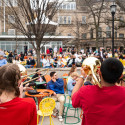Workers spruce up campus lecture halls
This is not your father’s lecture hall.
For starters, the chairs in 6210 Social Science are padded, spacious and ergonomically constructed. They are, in a word, comfortable.
 Chuck Bellin, a former Badger football player and now Flowers Electric Co. worker, installs conduit for audio-visual systems during renovation of 113 Psychology. |
Yet the new chairs are just one of the many features that campus facility experts have included in this classroom as part of a relatively new remodeling program. Called the Instructional Technology Improvements Program, it targets large lecture halls for renovation, transforming them from drab, uninspiring chambers into bright, engaging learning environments with state-of-the-art teaching technology.
“This used to be such a cold, sterile room,” Kim Todd of the Space Management Office says as he enters 6210 Social Science. Now, multi-colored acoustical panels line the off-white walls on both sides of the room. Two video projectors drop down from the ceiling at the front of the room, while two slide projectors sit at the back.
The room has better lighting, improved sound, increased access for the disabled — and of course the new chairs, colored purple, blue and red. Twenty-six seats were removed from the classroom (there are now 452) to give students more space.
The changes benefit not only students: Faculty have at their fingertips access to the latest in multimedia teaching tools.
In 6210 Social Science, instructors can control the video and slide projectors, two document cameras, which operate similarly to overheads, and the room’s lights from a large black control panel at the left of the stage. Professors can plug in their laptops and run computer programs that are beamed through the projectors onto a 26-by-12 movie screen, made of rubberized cloth, at the front of the room.
Faculty who teach in the room affectionately call the control panel “the bunker,” because of its size. Wireless microphones and computer mice, however, allow instructors to move out of “the bunker” and more fully engage students as they teach using the new technology.
“We are trying to get away from the instructor droning away up here,” says Todd, standing next to the control panel.
The university spent $1.2 million in the 1995-97 state budget cycle sprucing up 6210 Social Science and B130 Van Vleck Hall. It is spending another $1.5 million in the current biennium to renovate 2650 Humanities, 113 Psychology and 104 Van Hise Hall.
The Space Management Office plans the renovations by focusing on lecture halls that have been divided into “technology zones” according to their location on campus. Faculty advisory committees provided input into the design of the rooms. UW–Madison has more than 500 classrooms, and Todd’s office manages 376 of them.
The funding comes from the UW System’s classroom improvement program. In 1995-97, the university system spent $3.9 million renovating 80 of its lecture halls, and this budget cycle it is spending $6 million to remodel 110 classrooms, says Nancy Ives, UW System vice president for capital planning and budget.
The Board of Regents requested $15 million in state-supported borrowing for the program as part of its 1999-2001 construction budget. The funding will be part of the new WisBuild program, which will give the regents more flexibility in planning and paying for construction projects.
“Since about half of the UW System’s classrooms are at UW–Madison, it’s anticipated that UW–Madison will receive a significant portion of the funding,” Ives says. “Ultimately, it’s up to the regents.”



